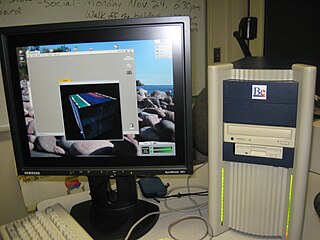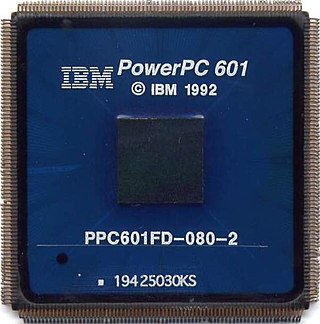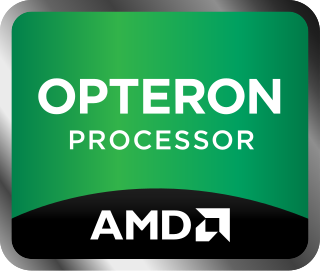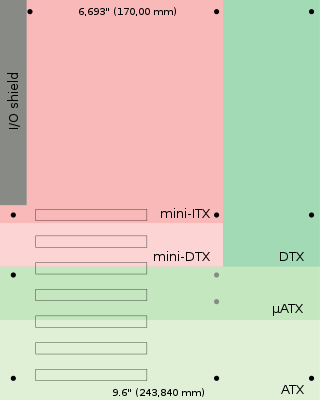
The BeBox is a discontinued personal computer from Be Inc., running the company's operating system, later named BeOS. It has two PowerPC CPUs, its I/O board has a custom "GeekPort", and the front bezel has "Blinkenlights".

A motherboard is the main printed circuit board (PCB) in general-purpose computers and other expandable systems. It holds and allows communication between many of the crucial electronic components of a system, such as the central processing unit (CPU) and memory, and provides connectors for other peripherals. Unlike a backplane, a motherboard usually contains significant sub-systems, such as the central processor, the chipset's input/output and memory controllers, interface connectors, and other components integrated for general use.

PowerPC is a reduced instruction set computer (RISC) instruction set architecture (ISA) created by the 1991 Apple–IBM–Motorola alliance, known as AIM. PowerPC, as an evolving instruction set, has been named Power ISA since 2006, while the old name lives on as a trademark for some implementations of Power Architecture–based processors.

Opteron is AMD's x86 former server and workstation processor line, and was the first processor which supported the AMD64 instruction set architecture. It was released on April 22, 2003, with the SledgeHammer core (K8) and was intended to compete in the server and workstation markets, particularly in the same segment as the Intel Xeon processor. Processors based on the AMD K10 microarchitecture were announced on September 10, 2007, featuring a new quad-core configuration. The last released Opteron CPUs are the Piledriver-based Opteron 4300 and 6300 series processors, codenamed "Seoul" and "Abu Dhabi" respectively.

Mini-ITX is a 170 mm × 170 mm motherboard form factor developed by VIA Technologies in 2001. Mini-ITX motherboards have been traditionally used in small-configured computer systems. Originally, Mini-ITX was a niche standard designed for fanless cooling with a low power consumption architecture, which made them useful for home theater PC systems, where fan noise can detract from the cinema experience.

Geode was a series of x86-compatible system-on-a-chip (SoC) microprocessors and I/O companions produced by AMD, targeted at the embedded computing market.

In-system programming (ISP), or also called in-circuit serial programming (ICSP), is the ability of some programmable logic devices, microcontrollers, chipsets and other embedded devices to be programmed while installed in a complete system, rather than requiring the chip to be programmed prior to installing it into the system. It also allows firmware updates to be delivered to the on-chip memory of microcontrollers and related processors without requiring specialist programming circuitry on the circuit board, and simplifies design work.
The PowerPC 600 family was the first family of PowerPC processors built. They were designed at the Somerset facility in Austin, Texas, jointly funded and staffed by engineers from IBM and Motorola as a part of the AIM alliance. Somerset was opened in 1992 and its goal was to make the first PowerPC processor and then keep designing general purpose PowerPC processors for personal computers. The first incarnation became the PowerPC 601 in 1993, and the second generation soon followed with the PowerPC 603, PowerPC 604 and the 64-bit PowerPC 620.

PowerUP boards were dual-processor accelerator boards designed by Phase5 Digital Products for Amiga computers. They had two different processors, a Motorola 68000 series (68k) and a PowerPC, working in parallel, sharing the complete address space of the Amiga computer system.

Skylake is Intel's codename for its sixth generation Core microprocessor family that was launched on August 5, 2015, succeeding the Broadwell microarchitecture. Skylake is a microarchitecture redesign using the same 14 nm manufacturing process technology as its predecessor, serving as a tock in Intel's tick–tock manufacturing and design model. According to Intel, the redesign brings greater CPU and GPU performance and reduced power consumption. Skylake CPUs share their microarchitecture with Kaby Lake, Coffee Lake, Whiskey Lake, and Comet Lake CPUs.

Ivy Bridge is the codename for Intel's 22 nm microarchitecture used in the third generation of the Intel Core processors. Ivy Bridge is a die shrink to 22 nm process based on FinFET ("3D") Tri-Gate transistors, from the former generation's 32 nm Sandy Bridge microarchitecture—also known as tick–tock model. The name is also applied more broadly to the Xeon and Core i7 Extreme Ivy Bridge-E series of processors released in 2013.

Broadwell is the fifth generation of the Intel Core processor. It is Intel's codename for the 14 nanometer die shrink of its Haswell microarchitecture. It is a "tick" in Intel's tick–tock principle as the next step in semiconductor fabrication. Like some of the previous tick-tock iterations, Broadwell did not completely replace the full range of CPUs from the previous microarchitecture (Haswell), as there were no low-end desktop CPUs based on Broadwell.

Socket AM4 is a PGA microprocessor socket used by AMD's central processing units (CPUs) built on the Zen and Excavator microarchitectures.

Socket AM5 is a zero insertion force flip-chip land grid array (LGA) CPU socket designed by Advanced Micro Devices (AMD) that is used for AMD Ryzen microprocessors starting with the Zen 4 microarchitecture. AM5 was launched in September 2022 and is the successor to AM4.
This page is based on this
Wikipedia article Text is available under the
CC BY-SA 4.0 license; additional terms may apply.
Images, videos and audio are available under their respective licenses.












